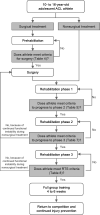Anterior Cruciate Ligament Rehabilitation for the 10- to 18-Year-Old Adolescent Athlete: Practice Guidelines Based on International Delphi Consensus
- PMID: 37492781
- PMCID: PMC10363891
- DOI: 10.1177/23259671231172454
Anterior Cruciate Ligament Rehabilitation for the 10- to 18-Year-Old Adolescent Athlete: Practice Guidelines Based on International Delphi Consensus
Abstract
Background: There are 2 treatment options for adolescent athletes with anterior cruciate ligament (ACL) injuries-rehabilitation alone (nonsurgical treatment) or ACL reconstruction plus rehabilitation. However, there is no clear consensus on how to include strength and neuromuscular training during each phase of rehabilitation.
Purpose: To develop a practical consensus for adolescent ACL rehabilitation to help provide care to this age group using an international Delphi panel.
Study design: Consensus statement.
Methods: A 3-round online international Delphi consensus study was conducted. A mix of open and closed literature-based statements were formulated and sent out to an international panel of 20 ACL rehabilitation experts. Statements were divided into 3 domains as follows: (1) nonsurgical rehabilitation; (2) prehabilitation; and (3) postoperative rehabilitation. Consensus was defined as 70% agreement between panel members.
Results: Panel members agreed that rehabilitation should consist of 3 criterion-based phases, with continued injury prevention serving as a fourth phase. They also reached a consensus on rehabilitation being different for 10- to 16-year-olds compared with 17- and 18-year-olds, with a need to distinguish between prepubertal (Tanner stage 1) and mid- to postpubertal (Tanner stages 2-5) athletes. The panel members reached a consensus on the following topics: educational topics during rehabilitation; psychological interventions during rehabilitation; additional consultation of the orthopaedic surgeon; duration of postoperative rehabilitation; exercises during phase 1 of nonsurgical and postoperative rehabilitation; criteria for progression from phase 1 to phase 2; resistance training during phase 2; jumping exercises during phase 2; criteria for progression from phase 2 to phase 3; and criteria for return to sports (RTS). The most notable differences in recommendations for prepubertal compared with mid- to postpubertal athletes were described for resistance training and RTS criteria.
Conclusion: Together with available evidence, this international Delphi statement provides a framework based on expert consensus and describes a practice guideline for adolescent ACL rehabilitation, which can be used in day-to-day practice. This is an important step toward reducing practice inconsistencies, improving the quality of rehabilitation after adolescent ACL injuries, and closing the evidence-practice gap while waiting for further studies to provide clarity.
Keywords: adolescent athlete; anterior cruciate ligament injury; nonsurgical rehabilitation; postoperative rehabilitation; prehabilitation.
© The Author(s) 2023.
Conflict of interest statement
The authors declared that there are no conflicts of interest in the authorship and publication of this contribution. AOSSM checks author disclosures against the Open Payments Database (OPD). AOSSM has not conducted an independent investigation on the OPD and disclaims any liability or responsibility relating thereto.
Figures
References
-
- Albarquoni L, Hoffman T, Straus S, et al.Core competencies in evidence-based practice for health care professionals: consensus statement based on a systematic review and Delphi study. JAMA Netw Open. 2018;1(2):e180281. - PubMed
-
- Balzer BWR, Gardem FL, Amatoury M, et al.Self-rated Tanner stage and subjective measures of puberty are associated with longitudinal gonadal hormone changes. J Pediatr Edocrinol Metab. 2019;32(6):569–576. - PubMed
-
- Beaudouin F, Rössler R, Aus der Fünten K, et al.Effects of the “11+ Kids” injury prevention programme on severe injuries in children’s football: a secondary analysis of data from a multicentre cluster-randomised controlled trial. Br J Sports Med. 2019;53(22):1418–1423. - PubMed
-
- Behringer M, vom Heede A, Yue Z, Mester J. Effects of resistance training in children and adolescents: a meta-analysis. Pediatrics. 2010;126(5):e1199–e1210. - PubMed
LinkOut - more resources
Full Text Sources
Miscellaneous



